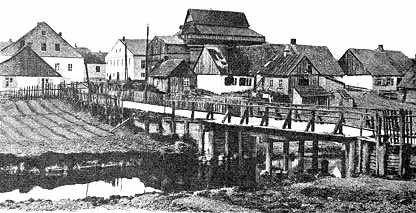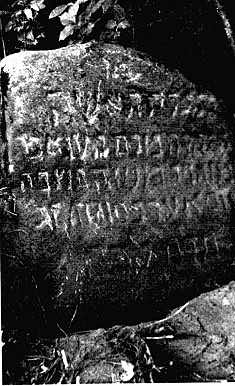
In the middle of the eighteenth century a cholera epidemic hit the town of Vizhan (Wizajny - now Poland) about 35 km south of Vilkovishk. Jewish refugees from there who were not allowed to enter Vilkovishk, settled in a forest nearby and the community of Vilkovishk supplied them with food. Many of them died and were buried near the forest. Descendants of these Jews later settled in Vilkovishk and lived there till the Holocaust.
A community committee consisting of the Rabbis and the respected personalities of the community administered public life. This committee managed all the religious, educational and welfare institutions. State rule in general did not intervene in interior issues of the Jews, thus the Rabbis were authorized to register births and deaths, to collect taxes for community needs and also to act as judges in conflicts among community members. The notebook (Pinkas) of the community from the years 1692-1833 is located in the Central Archives of the History of the Jewish People in Jerusalem.
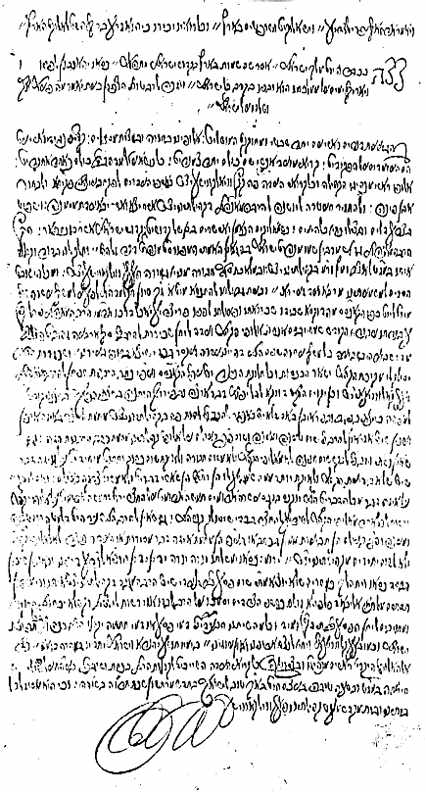
A page in the Pinkas
During the nineteenth century the Jews were the majority of the entire population of Vilkovishk. In 1857, out of a total of 5,503 people in the town, 4,559 were Jews (83%), and by 1897 this had increased to 5,788 people, but included only3,480 Jews (60%).
During the years 1869/70 Jewish immigration to America started. In a list of immigrants from Vilkovishk the following names appear: L.Aronberg, H.Volkovitz, A.Varshavsky, M.London, S.Levi, M.B.Lichtenstein, S.Neuman, T.Memlonusky, S.Karigarsky.
In the eighties and nineties of the nineteenth century Jews from Russia would arrive in Vilkovishk in order to cross the border to Germany without a passport, and from there to sail to America. This was attempted for mostly financial or political reasons, but sometimes the smugglers were caught by the Russian Border Guard, whereupon the Vilkovishk community was obliged to free these Jews from jail. In 1898 a warning was published in the Hebrew newspaper "Hatsefira" (printed in Warsaw) against attempting to cross the border without a passport, signed on behalf of the community of Vilkovishk by: Rabbi Zvi Mah-Yafith, Rabiner (official Rabbi) Eliyahu Shereshevsky; Trustees: Sender Turberg, Efraim-Mendel Pustapedsky; Gabaim (honorary officers): Yechezkel Yafe and Yehosua Lipman Yofe.
Over the years the Jews concentrated on trade in grains, timber and agricultural products designated for export to Germany. There were Jews in Vilkovishk who owned considerable fields (according to the Napoleon Codex Jews could acquire land in this region), also growing vegetables and fruits. The fire of 1882 harmed 180 Jewish families, and in 1886 300 Jewish houses burnt down. The fire of 1905 destroyed many Jewish houses, resulting in help being supplied by the Jewish French "Alliance" association and Barons Rothschild and Hirsch.
There were many Jewish shopkeepers, various artisans and car and carriage owners who transported goods and passengers to the railway station and to neighboring towns. In particular the industry of processing pig bristles for the production of brushes was developed in Vilkovishk. There were four big factories of this kind — belonging to Sobolevitz, Rozin, Vilkovisky and Vindsberg - who employed more than 400 Jewish workers in addition to several smaller workshops. These workers were the first ones who organized and arranged strikes in order to improve their working conditions.
In 1896 a strike took place in Vindsberg's factory, organized by members of the "Bund" party from Vilna (Avraham Alexandrovitz and Ortshik), the workers demanding to reduce daily working hours to 10, and they achieved their goal. At that time the "Union of the Brush Workers" was established, and in 1898 a proclamation "To the Jewish Brush Workers in Lithuania and Poland" concerning the struggle for workers rights was issued by this union. The "Bund" also organized illegal demonstrations causing collisions with the police and some of the demonstrators were detained (the tailor Voloch, Shmuel Joffe, Eliyahu Slitovsky, Yisrael Kenigsberg). In 1911 about 1000 bristles workers, mostly Jewish, struck in order to achieve an eight-hour working day and a supplement of 75 Kopeiki (100 Kopeiki=1 Ruble) per week, thus becoming the first workers in Lithuania to benefit from an eight-hour day. The "Bund" organization fought not only for workers rights, but also propagated knowledge and Yiddish culture among the working classes.
There were many prayer houses in town: the old synagogue, the "Beth Midrash", four "Klois'es": the German, the French - where Napoleon's soldiers had lodged - the "Chevrah Kadisha" and the R' Ya'akov Yeshayahu, and one "Shtibl". The brush workers had their own prayer house which was called "Chevrath Sh"Ch (Hebrew
initials of Pig Hair) This society (Chevrah) was established in 1875, initiated by the "Magid" from Kelem (Kelme) who taught those workers "Chayei Adam" and "Mishnah" (see the front page of the "Pinkas" of this society, below).
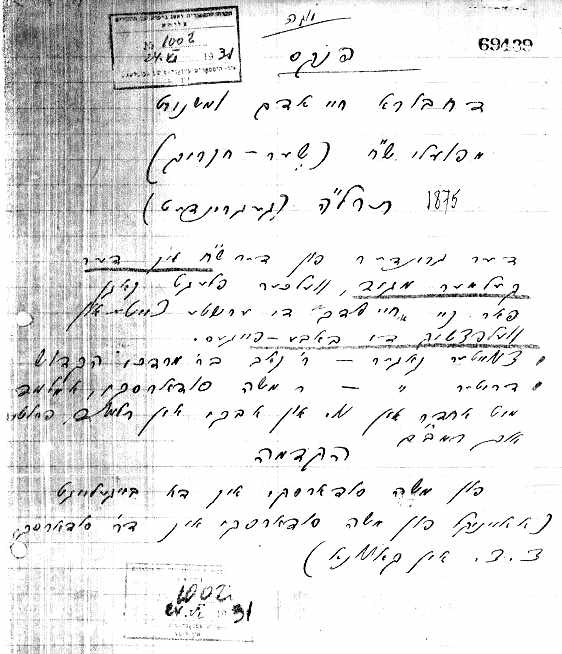
A "Chevrah Kadisha" was also active, whose "Pinkas" (Notebook) existed from 1811 and "Chevrath Mishnah" whose "Pinkas" already existed in 1761.
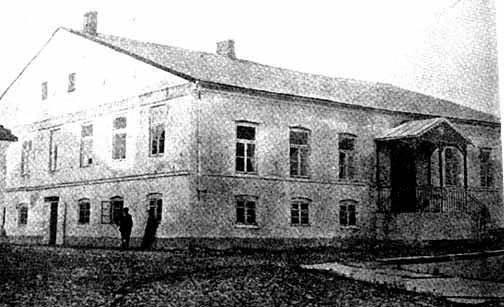
The "Beth Midrash"
Education of Jewish children was mainly in the hands of "Melamdim" (religious teachers), and at the end of the nineteenth century the "Melamed" Moshe Sudarsky, very beloved by his pupils and honored by the entire public, became famous in Vilkovishk. Many pupils of the "Chadarim" and "Talmud Torah" continued their studies in the "Yeshivoth" in town or in neighboring towns.
In 1867 there was a Russian-Jewish school, with one of its teachers being Nachum-Tuvia London, who immigrated to America in 1895, published articles in the Hebrew press there and also participated in the writing of the English Jewish Encyclopedia. In 1879 there was a school directed by Rabiner E.Shereshevsky, and in 1903 he established a school with three classes, in which religious and general subjects were taught.
Part of the youth were fluent in the Hebrew language and showed great interest in the origins of the new Hebrew literature. An association called the "Distributors of Knowledge" (among the Jews) in Russia sent Hebrew books and periodicals which were received with excitement, and letters of thanks were sent to the distributors.
In those years the "Sopher" (Scribe) Moshe was famous in Vilkovishk and its surroundings, as a writer of Scriptures and as an artist who created more than 500 artistic "Mizrach" signs indicating the east, the direction towards Jerusalem, which were fixed on the eastern walls of many Jewish homes, and many "L'Shanah Tovah" signs. The climax of his work was a "Sidur" (prayer book) written by hand and ornamented, which he prepared for the "Home for the Aged" in town.
Among the Rabbis who served in Vilkovishk during this period were: Eliezer Landa (1791-1886); Ya'akov David Vilevsky (1845-1914); Zvi Hirsh Mah-Yafith (1840-1919).
Among the "Dayanim" (Religious Judges) were Ya'akov Rabinovitz; Ya'akov Shpaier; Yehudah Yitshak Segal; Elchanan Haparush; Dov-Ber Kamaika; Chananyah Cohen.
Many welfare institutions were active in Vilkovishk: "Gemiluth Chasadim" (ran a "Pinkas" from 1800); "Maskil el Dal" (their "Pinkas" dates from1880) giving loans to the needy without interest and small payments for returning the money; "Mathan BeSeter" which helped people whose economic situation had deteriorated and who were embarrassed to ask for help; "Maoth Chitim" provided the needy with necessities for "Pesach". In 1910 all four institutions were united into one big institution "Tsedaka Gedolah". "Hachnasath Kalah" helped poor brides; "Linath haTsedek" supplied poor passers-by with food and accommodation; "Bikur Cholim" helped needy patients and sent them doctors and medicines. There were also Jewish public baths and several "Mikve". In 1912 the community built a magnificent "Home for the Aged" with a lovely garden.
Zionist activity had started in the eighties of the nineteenth century, and expressed itself in publicity and fund raising for the settlement of Eretz-Yisrael. Yitshak Eliezer Izersky, a pharmacist, immigrated to Eretz-Yisrael in the seventies of the eighteenth century and opened a shop of medicines in Yaffo. Vilkovishk Jews who immigrated to Eretz-Yisrael at that time were Rabbi Zevulun Charlap (died in Jerusalem in 1898) and Adinah Cahansky (arrived in 1902), who opened a restaurant in Rishon leZion which became a meeting place for writers and workers’ leaders. She published articles in the periodical "Hapoel HaTzair" and was a member of the local council.
In the old cemetery of Jerusalem there are three tombstones of Vilkovishk Jews: Zeev-Wolf son of David (died in1878); Yitshak son of Moshe HaCohen (died in 1888); Zvi son of Aharon HaCohen (died in1899).
The "Zion" society in town, headed by pharmacist
Fainberg, had 400 members in 1899. At the regional conference of
Zionist Societies, which took place in1899 in Vilna, Rabbi Zvi
Mah-Yafith participated as delegate from Vilkovishk. On "Chol HaMoed
Succoth" 1903 the "Center of the Zionist Societies of Suvalk
Gubernia" gathered in Vilkovishk and there drafted regulations for
the societies' activities, which were adopted. In 1901-1902 about 200
"Shekalim" (membership card of the Zionist organization) were sold in
town. At that time 500 shares of the so-called "Colonial Bank" (The
Jewish Colonial Trust Ltd., established by Dr.Herzl at the second
Zionist Congress in 1899, the predecessor of the Anglo-Palestine
Bank), each of one pound, were sold in Vilkovishk. In the summer of
1913, before the 11th
During these years the "Tseirei Zion" and "Poalei Zion-Smol" parties acted in town and were a counter weight to the ant-Zionist "Bund".
During WW1 Vilkovishk passed several times from one administration to another, the Jews suffering from abuse and maltreatment by Russian soldiers, and many left. During the German occupation (1915-1918) the Jews, like every one else, suffered from the various restrictive edicts of occupation rule and Jewish community life was paralyzed. The Jewish Bendet Rabinovitz was the mayor of Vilkovishk during these years.
